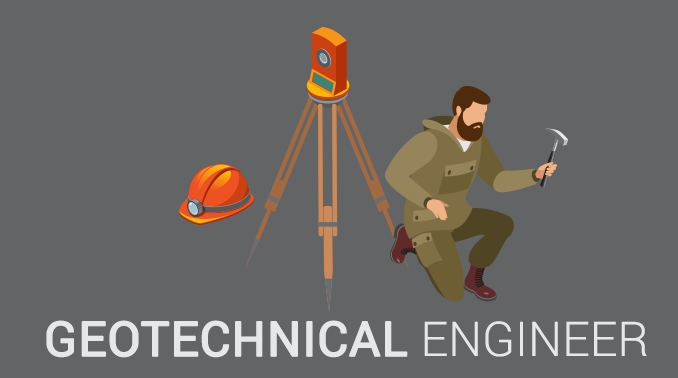The Ultimate Guide To Geotheta
The Ultimate Guide To Geotheta
Blog Article
Things about Geotheta
Table of ContentsSome Known Details About Geotheta The Ultimate Guide To GeothetaGeotheta - The FactsTop Guidelines Of GeothetaGetting My Geotheta To Work

They conduct website examinations, accumulate samples, execute laboratory tests, and analyze data to examine the viability of the ground for construction jobs - Engineer of Record. Based on their findings, geotechnical engineers supply suggestions for foundation design, slope stability, preserving structures, and reduction of geotechnical hazards. They work together with various other specialists, such as architects, architectural designers, and building and construction teams, to guarantee that geotechnical factors to consider are incorporated right into the general task layout and implementation
By evaluating the behavior and residential properties of dirt and rock, they can recognize possible geotechnical hazards such as landslides, soil settlement, or slope instability. Their proficiency helps stop failures or crashes that could jeopardize lives and home. Below are some comprehensive tasks and obligations of a geotechnical engineer: Site Examination: Geotechnical designers conduct site examinations to collect data on subsurface problems.
They translate the data to recognize the properties and actions of the soil and rock, including their stamina, leaks in the structure, compaction characteristics, and groundwater problems. Geotechnical Analysis and Style: Geotechnical engineers examine the data collected during website investigations to examine the stability and viability of the website for building and construction projects. They carry out geotechnical computations and modeling to review factors such as birthing capacity, settlement, incline stability, lateral planet pressures, and groundwater flow.
The Ultimate Guide To Geotheta
Foundation Style: Geotechnical designers play a crucial function in developing structures that can safely sustain the designated structure. They analyze the soil conditions and tons requirements to figure out the appropriate structure kind, such as shallow structures (e.g., grounds), deep structures (e.g (https://issuu.com/geotheta)., stacks), or specialized strategies like dirt renovation. They consider factors such as settlement restrictions, birthing capability, and soil-structure interaction to create optimum structure styles
They evaluate construction strategies, display site tasks, and perform field assessments to validate that the layout suggestions are complied with. If unpredicted geotechnical problems develop, they examine the circumstance and provide suggestions for remediation or changes to the design. Threat Evaluation and Mitigation: Geotechnical designers analyze geotechnical dangers and risks related to the project website, such as landslides, liquefaction, or soil erosion.

Cooperation and Communication: Geotechnical designers function closely with various other experts involved in a task, such as architects, architectural engineers, and construction groups. Efficient interaction and cooperation are necessary to incorporate geotechnical considerations right into the general project style and building and construction procedure. Geotechnical engineers supply technical knowledge, solution questions, and make sure that geotechnical requirements are met.
Unknown Facts About Geotheta
Right here are some kinds of geotechnical designers: Structure Designer: Foundation engineers specialize in creating and evaluating structures for frameworks. They assess the dirt problems, lots needs, and site features to determine one of the most ideal structure type and design, such as shallow foundations, deep foundations, or specialized methods like stack structures.
They examine the aspects affecting incline stability, such as soil homes, groundwater conditions, and slope geometry, and develop strategies to avoid slope failings and reduce dangers. Earthquake Engineer: Earthquake engineers concentrate on assessing and designing frameworks to stand up to seismic pressures. They analyze the seismic hazard of a site, review dirt liquefaction potential, and create seismic layout standards to ensure the safety and resilience of frameworks throughout earthquakes.
They perform field screening, accumulate samples, and evaluate the collected information to define the soil properties, geologic formations, and groundwater problems at a site. Geotechnical Instrumentation Engineer: Geotechnical instrumentation designers concentrate on monitoring and gauging the habits of soil, rock, and frameworks. They set up and preserve instrumentation systems that monitor factors such as dirt negotiation, groundwater degrees, slope motions, and structural variations to assess efficiency and offer very early cautions of potential concerns.
The Basic Principles Of Geotheta
They conduct Click This Link tests such as triaxial tests, consolidation tests, straight shear tests, and permeability examinations to collect information for geotechnical analysis and style. Geosynthetics Designer: Geosynthetics designers focus on the style and application of geosynthetic products, such as geotextiles, geogrids, and geomembranes. They use these materials to improve dirt stability, strengthen slopes, supply drain solutions, and control erosion.
They tend to be investigatory individuals, which means they're intellectual, introspective, and analytical. They are curious, methodical, logical, analytical, and rational. Some of them are additionally social, indicating they're kind, charitable, cooperative, person, caring, handy, empathetic, tactful, and pleasant. Does this seem like you? Take our free job test to discover out if geotechnical designer is among your top profession matches.
In the workplace atmosphere, geotechnical engineers use specialized software program devices to execute estimations, create styles, and assess information. They prepare reports, evaluation task requirements, interact with customers and staff member, and coordinate task activities. The workplace setup supplies a favorable setting for research study, evaluation, and cooperation with other specialists associated with the job.
The Geotheta Diaries
They regularly check out task sites to perform site examinations, examine geotechnical conditions, and collect information for analysis. These sees entail taking a trip to different places, in some cases in remote or tough terrains. Geotechnical designers might do dirt sampling, conduct examinations, and screen building and construction activities to make sure that the geotechnical facets of the project are being applied correctly.
Geotechnical designers additionally operate in specialized geotechnical laboratories. In these centers, they perform experiments, carry out tests on dirt and rock samples, and analyze the design buildings of the materials. Geotechnical laboratory engineers function thoroughly in these settings, handling testing equipment, operating instruments, and tape-recording data. They collaborate with other lab personnel to make certain precise and reliable screening results.
Report this page